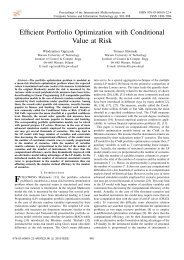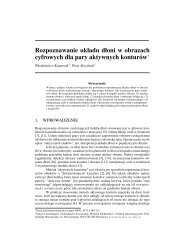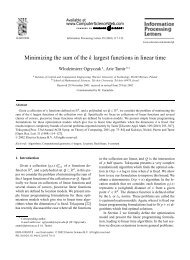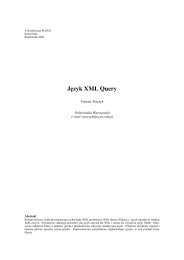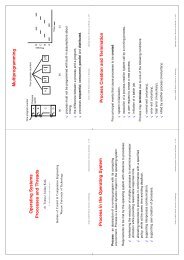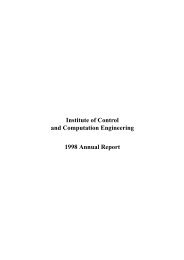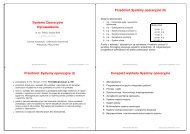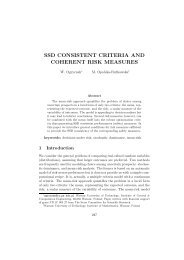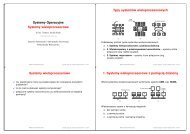Subsidize-free cost allocation method for infrastructure ... - Ozyrys
Subsidize-free cost allocation method for infrastructure ... - Ozyrys
Subsidize-free cost allocation method for infrastructure ... - Ozyrys
Create successful ePaper yourself
Turn your PDF publications into a flip-book with our unique Google optimized e-Paper software.
and resource constraint is limited by ˜b i . Game players <strong>for</strong>m<br />
group S ∈ I of players called coalition if only constraints<br />
related to them are xed with their values from vector ˜b<br />
and all other constraints are completely relaxed. We denote<br />
<strong>infrastructure</strong> <strong>cost</strong> <strong>for</strong> coalition S as a C(S). Further we use<br />
notation C(S) <strong>for</strong> <strong>infrastructure</strong> <strong>cost</strong> of subset S of players<br />
and C(b) <strong>for</strong> <strong>infrastructure</strong> <strong>cost</strong> <strong>for</strong> resources availability at<br />
level b, where C(S) = C(b ′ ), b ′ i = ˜b i <strong>for</strong> i ∈ S, b ′ i = ∞ or<br />
−∞ respectively <strong>for</strong> i ∉ S.<br />
Denition 1. Allocation is <strong>free</strong> from subsidizing if it<br />
satises incremental <strong>cost</strong> test<br />
a(S) ≥ C(N) − C(N \ S), (7)<br />
where a(S) = ∑ i∈S x i.<br />
Denition 2. Allocation rule ϕ(C, ˜b) is <strong>free</strong> from subsidizing<br />
<strong>for</strong> class of <strong>cost</strong> functions C if it produces <strong>allocation</strong><br />
<strong>free</strong> from subsidizing <strong>for</strong> every admissible ˜b and C ∈ C.<br />
Coalition S is encouraged to dissolve if <strong>cost</strong> allocated on<br />
coalition S is lower then marginal benet related to coalition<br />
S dissolving, thus equations (7) are satised. Only in this<br />
case <strong>cost</strong> allocated on system constraints are sufciently<br />
incentive to motivate players to remove their constraints<br />
(at least not to make them more restrictive). Let's assume,<br />
that condition (7) is not satised <strong>for</strong> subset S. Eliminating<br />
constraints (7) reveals <strong>cost</strong>s C(N)−C(N \S). Nevertheless,<br />
if <strong>allocation</strong> a(S) is lower then joint <strong>cost</strong>s C(N)−C(N \S)<br />
then coalition S must be subsidized by other players.<br />
Notice, that efciency property (6) together with (7)<br />
constitute denition of game core. Core of the game is<br />
an nonempty set <strong>for</strong> many problems from important wellknown<br />
class of games pNAD. Set of games pNAD is a set<br />
of non-atomic, additive games of bounded variation with<br />
polynomial, continuously differentiable <strong>cost</strong> function [10].<br />
Games class pNAD is important due to unique <strong>allocation</strong><br />
scheme (Aumann-Shapley pricing) which meets widely acknowledged<br />
set of axioms <strong>for</strong> <strong>allocation</strong> rule. Un<strong>for</strong>tunately,<br />
IMG does not belong to pNAD, because C is not continuously<br />
differentiable and game is not additive.<br />
Lemma 1. Break-even and subsidize-<strong>free</strong> <strong>allocation</strong> rule<br />
exists only if characteristic function C satises<br />
m∑<br />
C(I) ≤ [<br />
i=1<br />
C(I \ S i )]/(m − 1) (8)<br />
Proof. Let's<br />
⋃split set I into m disjoint subsets<br />
S 1 , S 2 , . . . , S m , m<br />
i=1 S i = I, S j ∩ S k = ∅, ∀j, k ∈<br />
{1, . . . , m}, j ≠ k. According to (7) an <strong>allocation</strong> is <strong>free</strong><br />
from subsidizing if the following conditions are satised<br />
C(I) − C(I \ S i ) ≤ a(S i ) i = 1, . . . , m (9)<br />
By summing up the inequalities (9) we obtain<br />
m∑<br />
m∑<br />
mC(I) − C(I \ S i ) ≤<br />
∑<br />
i=1<br />
i=1<br />
a(S i ) i = 1, . . . , m (10)<br />
An <strong>allocation</strong> satises break-even property if the equalities<br />
i∈I x i = ∑ m<br />
i=1 a(S i) = C(I) are met. By substituting this<br />
equation in the inequality (10) we obtain<br />
m∑<br />
C(I) ≤ [<br />
i=1<br />
C(I \ S i )]/(m − 1) (11)<br />
Thus, the function C must satisfy conditions (8) to make<br />
the <strong>free</strong> from subsidizing property preserving possible. □<br />
From the lemma 1 it comes that there is no universe<br />
<strong>free</strong> from subsidizing and break-even <strong>allocation</strong> rule <strong>for</strong> all<br />
possible functions C. For m = 2 this condition trans<strong>for</strong>ms<br />
into subadditivity denition. For m > 2 this condition is<br />
even more stronger.<br />
Theorem 1. Any break-even <strong>allocation</strong> rule <strong>for</strong> IMG is<br />
not subsidize-<strong>free</strong>.<br />
Proof comes straightly from previous lemma when we<br />
observe that characteristic function of IMG is not subadditive<br />
and does not meet condition (8).<br />
From theorem 1 it comes that only <strong>allocation</strong> rules that<br />
break the efciency axiom can be subsidize-<strong>free</strong>. Nevertheless,<br />
when core of game is empty, many researches relax<br />
the conditions (7) and use <strong>for</strong>mulation of ɛ-core (e.g. <strong>for</strong> bin<br />
packing game see [8]) keeping the efciency axiom. ɛ-core<br />
is dened by the following conditions<br />
a(S) ≥ (1 − ɛ)(C(N) − C(N \ S)), ɛ ∈ 〈0; 1〉 (12)<br />
Sentence 1. Any <strong>allocation</strong> in ɛ-core, ɛ > 0, but not in<br />
0-core is not subsidize-<strong>free</strong>.<br />
Proof of the sentence is evident, because inequalities (7)<br />
are in fact 0-core denition (12). Since <strong>for</strong> ɛ > 0 this<br />
obviously violates the conditions <strong>for</strong> subsidize-<strong>free</strong> <strong>allocation</strong><br />
in denition 1, we are interested in holding 0-core (original,<br />
not relaxed core denition) property.<br />
Thus, the only way to achieve subsidize-<strong>free</strong> <strong>allocation</strong> is<br />
to relax efciency condition. Because majority of <strong>method</strong>s<br />
known in the literature assume that <strong>allocation</strong> must be<br />
break-even, they cannot allow to nd <strong>free</strong> from subsidizing<br />
<strong>allocation</strong>.<br />
Theoretically, subsidize <strong>free</strong> <strong>allocation</strong> can be easily obtained<br />
– it is easy to show that it is sufcient to allocate high<br />
enough <strong>cost</strong> on each player. In practice we are interested in<br />
the possible small charges which would assure <strong>free</strong>dom from<br />
subsidizing.<br />
III. MASIT – A NEW COST ALLOCATION<br />
METHOD<br />
Under the assumption, that incremental <strong>cost</strong> test (7) must<br />
be satised <strong>for</strong> each coalition, we obtain the following system<br />
assuring subsidize-<strong>free</strong> <strong>allocation</strong>:<br />
∑<br />
x i ≥ C(I) − C(I \ S) ∀S ⊆ I (13)<br />
i∈S<br />
Each market entity responsible <strong>for</strong> system constraints demands<br />
the lowest possible charges. Thus, the following<br />
multi-criteria problem MASIT (Minimal Allocation Satisfying<br />
Incremental <strong>cost</strong> Test) can be <strong>for</strong>mulated.<br />
Problem MASIT:<br />
min (x 1 , x 2 , . . . , x n )<br />
x 1 ,x 2 ,...,x n<br />
(14)




